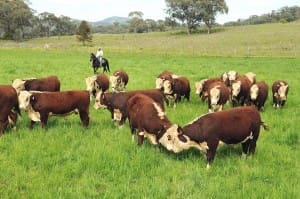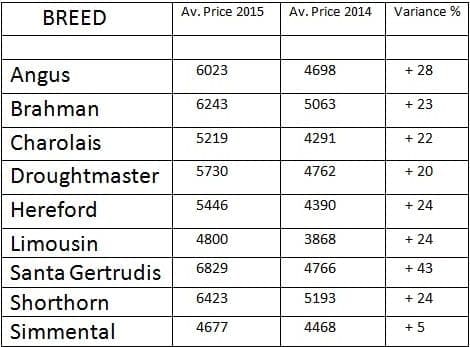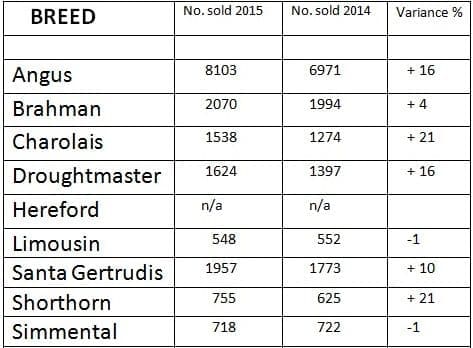THIS year’s big surge in cattle price has far outweighed any negative impact on results caused by dry weather and drought, Beef Central’s annual analysis of bull sale results for major breeds has shown.
All popular breeds have substantially lifted their average price for bulls sold at auction this year – some jumping as much as $1500 to $2000 in comparisons with 2014 results.
 Numbers sold results were mixed, with some breeds little changed in turnover on last year, while others were considerably higher.
Numbers sold results were mixed, with some breeds little changed in turnover on last year, while others were considerably higher.
Putting that into greater context, however, there was a big reduction in bulls offered between the 2013 and 2014 years, as two exceptionally wet years (leading to herd build-up) was followed by the first of the current dry/drought years. That trend was picked up in this earlier report.
That meant studmasters (particularly those servicing markets from northern NSW north) in many cases culled hard, to better align the size of their bull offerings with the number of breeders left in the paddock.
Numbers of bulls sold have risen this year, and equally significantly, the clearance rate at auction has improved for many larger breeds – some to near-record levels.
High trade-in value on old bulls
The rise in numbers sold has come as something of a surprise, but the simplest explanation for that, in the context of a declining cow-herd population across large parts of eastern Australia due to drought, is current high-trade value for cull bulls.
With prices for 90CL grinding beef into the US sitting at record levels between 600c/kg and 700c/kg for much of the past 12 months, there has been a compelling temptation for commercial cattlemen to retire older herd bulls, and replace them with genetically superior (in theory, at least) young herd improvers. Heavy bulls have routinely made $2000-$3000 at the meatworks this year, making the conversion to a younger replacement much less daunting.
It’s the simplest explanation for the significantly higher bull turnover seen this year, which has clearly had no negative effect whatsoever on price.
Price increases are simply pulling back lost ground
Putting this year’s results into some historical context, while the large average price rises evident in the breed breakdowns published below are encouraging, to some extent they simply correct some big declines in average price seen in many breeds in the 2013 year. That was only marginally improved-on in many cases last year.
Angus bulls, for example, fell more than 20pc in average value between 2012 and 2013, as the broader cattle market fell away, to $4837. Despite rising a hefty $1325 in value this year, average price for Angus bulls have still not reached the record set in 2012.
Stand by for some big bull sale results in 2016, though. In Beef Central’s opinion, the stage is set for record-setting, with the powerful combination of vibrant international demand for Australian beef, a low A$ value, and reduced herd size pushing processor, lotfeeder, grower and backgrounder competition for commercial cattle to record highs.
There’s every likelihood that that sentiment will be expressed, also, in next year’s bull selling market.
The only potential handbrakes on that are the risk of an over-supply of bulls, with a national beef herd size now at 20- year lows, and the other, ever-present risk of continued drought.
While in southern states, autumn bull sales held earlier this year struggled due to weather conditions, the spring sales cycle more than made up for that, with very strong results across the board.
Presented here are two tables for average price and numbers of bulls sold for 2015, relative to the year before. Note that the results for the nine largest breeds are for auction sales only, as it is impossible to account for paddock sales of bulls in any meaningful way. Also note that Hereford results are for a sample of sales only (further details below).
Average price
Number sold at auction
Below is a summary of individual breed results, appearing in descending order, based on this year’s average price:
Santa Gertrudis
There was a spectacular $2053 rise in average price among Santa Gertrudis bulls sold at auction this calendar year, lifting a massive 43pc in value to $6829. It’s easily the highest breed average recorded in this year’s survey, and a new benchmark record for the breed.
Numbers sold also improved significantly, lifting 10 percent to 1957 from 1763 last year. Clearance rates for Santa bulls sold at auction also lifted, from 85pc recorded last year to 94pc in 2015. That’s equal to the highest clearance rate recorded in five years of Beef Central’s bull-sale statistical reports.
Despite the standout result, 39pc of Santa bulls sold at auction this year still made $5000 or less.
Shorthorn:
Shorthorn bull breeders enjoyed a solid year of support from commercial bulls buyers, lifting both average price and numbers sold.
Bull numbers sold this year reached 755 head, a 21pc rise on the previous year, while clearance rates of bulls offered at auction lifted from 86pc to 90pc. Average price rose $1230 to $6423, a 23pc increase on last year.
Brahman:
The lift in fortunes for the northern cattle industry with live exports now back on track after the market dysfunction of 2011-13 has helped drive Brahman bull results solidly higher this year.
Nineteen Brahman bull auction sales held in Queensland, WA, NSW and the NT recorded a turnover of $14.334 million in 2015, up a spectacular 36.7pc on the previous year.
Average prices for registered and herd bulls (unlike some other breeds, unregistered herd bulls are still sold in some quantity in the Brahman industry) lifted by $1183 this year to $6243, an increase of 23.4pc on the previous year. The average for registered bulls increased by $1280 to a record $7219, a 21pc rise on the previous year.
Total bulls sold at auction reached 2070, an increase of 3.8pc on 2014 figures. Brahman clearance rates were not provided this year, because records of withdrawals from catalogues before bulls went to auction were not complete.
“We have again seen strong support for paddock sales which is pleasing, considering the amount of heartland Brahman bull-buying country that is in its second or third year of drought, with drastically reduced breeder numbers,” the Australian Brahman Breeders Association told Beef Central.
Angus:
“Black is Beautiful” is the popular slogan across large parts of southern Australia, and it rang true again in 2015.
Angus breeders logged nationwide auction sales of 8103 bulls in 2015, a new record for the breed for auction sales, up 16pc on last year’s figure of 6971.
Average price at auction also surged strongly, reaching $6023 – falling just short of the Angus breed’s record of $6069 set in 2012. That’s a spectacular 28pc rise on last year’s figure of $4698. Clearance rates at auction were not recorded, but if other breeds are anything to go by, were likely to be up this year.
Looking back, average price for Angus bulls back in 2007 across Australia was just $3924, showing a dramatic improvement since then, although there may have been an element of market over-supply in play in earlier times.
Angus Australia chief executive Pater Parnell agreed that the general strength of the cattle market and underlying producer confidence was the big factor in all bull sale results this year.
“It’s the key driver. In some ways it is somewhat surprising, because we were aware that there has been a big reduction in cow numbers across the country, and for that reason we thought it might have been a tougher year than how it turned out.”
“But the other factor is that trend for producers to take the opportunity to sell some older bulls on a very strong salvage market, buying in better genetics with a changeover price that was not too bad.”
Give the growth in numbers of Angus bulls sold recorded above, is there a risk of over-supplying the market?
“We don’t think the breed has reached saturation point,” Dr Parnell said.
“We remain optimistic that there is further growth potential for Angus ahead, both in southern and northern Australia. We’re still seeing that gradual shift across to Angus in the industry, driven by price premiums, growth in momentum in MSA and other factors.”
“We also see further growth potential in those non-ticky areas of northern Australia, and many of those areas are still under drought. Once things improve seasonally in that region, we’d expect to see more Angus crossbreeding going on, as more producers target premiums in the market.”
Droughtmaster
Droughtmasters logged another strong yearly result, despite the dry/drought conditions across many of the breed’s heartland bull buyer market areas this year.
Average price was almost $1000 a head higher this year than in 2014, reaching $5730 ($4762 last year), a 20 percent increase.
The price increase was achieved despite a substantial rise in Droughtmaster bulls offered, and sold.
Bulls offered (catalogued numbers, minus withdrawals) this year reached 1828, up 15.6pc on last year. Bulls sold reached 1624, a 16pc rise. Clearance rates also lifted this year, up another 1pc to 89pc.
Charolais
Charolais results again reflected the strong market preference for the breed in the Euro genetics segment.
There was a sharp 21 percent rise in the number of bulls sold, rising 264 to 1538 bulls for the year. On top of that, clearance rate at auction lifted significantly, from 74pc last year to 90pc in 2015. Clearance rates of 90pc were widespread across results reported for most major breeds in 2015.
Average price for Charolais bulls also improved sharply this year, lifting $928 or 22pc to $5219 – a new record for the breed, just eclipsing the $5210 result recorded in 2012.
Limousin:
Limousin bull breeders enjoyed a strong lift in average prices this year, for a similar number of bulls sold. Average price for bulls in 2015 was $4800, a 25pc rise over last year’s $3868.
The number of bulls sold at auction was virtually unchanged at 548 head, but clearance rate of bulls offered rose 3 pc to 77.5pc.
Simmental:
Simmentals followed the broader trend towards higher average prices for bulls this year, but perhaps not as acutely as some other breeds.
Bull breeders averaged $4677 for their completed transactions this year, up $277 or 6pc on 2014 figures ($4468).
Numbers of bulls transacted remained much the same, with 718 bulls sold, compared with 722 last year.
Hereford:
Herefords Australia was unable to provide full 12-month bull sale statistics, but provided results for those sales for which members provided figures. While this makes direct comparisons with other breeds impossible, it perhaps provides some guidance on the general trends in the Hereford breed, relative to others.
The report suggests an average price of $5446 for the sample of Hereford bulls recorded, and an average auction clearance of 82pc. Other breed literature suggests there were 1210 Hereford bulls sold over this year’s spring sales period, based on an 83pc clearance of 1459 bulls offered.
A different sample of overall Hereford sales reported by Beef Central last year averaged $4390 for 1355 bulls sold.
Data collected as part of Beef Central’s annual end-of-season summary shows that numbers of bulls sold at auction across the nine largest breeds lifted about 11 percent on the previous 2014 year.
Numbers sold this year across all nine breeds were still down about 1500 when compared with the 2012 year figures (19,400 bulls), which was regarded as probably a record for total number of bulls sold at auction across Australia.
Notes on the survey:
Beef Central’s annual survey is based on the nine largest breeds employed across the Australian beef industry – Brahman, Droughtmaster, Santa Gertrudis, Angus, Charolais, Limousin, Hereford, Shorthorn and Simmental. Collectively, they represent an estimated 90 percent of all bulls sold at auction across the nation.
Numbers sold at auction should not be used as any form of ‘popularity contest’ between breeds, however, as direct breed to breed comparisons lack value for several reasons. In the dominant tropically-adapted Brahman and Droughtmaster breeds, for example, an overwhelming majority of herd bulls are not sourced via the auction system, but out of the paddock, where no publicly-accessible records are kept.
Credible estimates have suggested that perhaps 60 percent of all Brahman bulls employed in northern Australian herds are either bought from seedstock breeders via paddock sales, or home-bred by commercial cattlemen retaining their own herd bull producing nucleus stud herds.
Most of the nation’s largest pastoral companies, for example, today breed all their own herd bull replacements.
- Beef Central has compiled statistics on average price and numbers of bulls sold for major breeds for the past five years. Click here to view last year’s report, and click here to view our 2013 report.





How many Brangus bulls were sold this year in comparison to those breeds? I know in qld they are a pretty major breed and was surprised to see you have not included them.
We’ve asked the Brangus Society for some statistics, and will report back, Lucy. Obviously the cut-off point at present, based on the ‘smallest’ breed on our list, is Limousin, with 548 bulls sold at auction on 2015. Editor.
I wondered why no mention has been made regarding the Brangus cattle in the summary. Every other breed was mentioned but no Brangus results. There was a Brangus bull sold at the Annual Sales in Rockhampton in October for $46,000, so I thought the Brangus breed was surely worth a mention.
Thanks for your comment, Marge. The list is based on what Beef Central understands to be the nine largest breeds, gauged by number of bulls sold at auction. Individual bull prices were not taken into account. Such lists have to be kept to a realistic number, given our limited manpower resources. Unfortunately there will always be a breed or two that fall just outside the scope of our report. Perhaps you might like to supply a second reader comment with the combined Brangus results for the year, which any readers perusing this article will see. – Editor